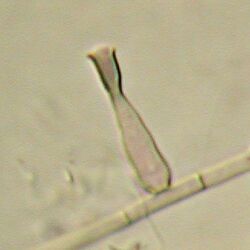Biology:Phialophora
From HandWiki
Short description: Genus of fungi
| Phialophora | |
|---|---|

| |
| Scientific classification | |
| Domain: | Eukaryota |
| Kingdom: | Fungi |
| Division: | Ascomycota |
| Class: | Eurotiomycetes |
| Order: | Chaetothyriales |
| Family: | Herpotrichiellaceae |
| Genus: | Phialophora Medlar (1915)[1] |
| Species | |
| |
Phialophora is a form genus of fungus with short conidiophores, sometimes reduced to phialides; their conidia are unicellular. They may be parasites (including on humans), or saprophytic (including on apples).[3][4]
Genetic analysis of Phialophora shows that it is a paraphyletic grouping.[5]
The conidia are produced from a flask shaped phialide. Mature, spherical, to oval conidia are extruded from phialides and usually accumulate around it.
Some members of Phialophora are involved in symbiotic relationships with leafcutter ants where they grow on the cuticle of the ants and fulfill a saprophytic role that aids in the fungal gardening on which the ants rely.[6][7]
References
- ↑ Medlar, E.M. (1915). "A New Fungus, Phialophora verrucosa, Pathogenic for Man". Mycologia 7 (4): 200–203. doi:10.2307/3753363.
- ↑ "Phialophora avicenniae sp. nov., a new endophytic fungus in Avicennia marina in China". Mycotaxon 124: 31–7. 2013. doi:10.5248/124.31.
- ↑ McColloch, L.P. (1944). "A Study of the Apple Rot Fungus Phialophora malorum". Mycologia 36 (6): 576–590. doi:10.2307/3754837.
- ↑ Barnett, H.L.; Hunter, B.B. (1972). Illustrated Genera of Imperfect Fungi. Burgess Publishing company, Minneapolis MN. ISBN 978-0-8087-0266-5.
- ↑ Abliz, P.; Fukushima, K.; Takizawa, K.; Nishimura, K. (2004). "Identification of pathogenic dematiaceous fungi and related taxa based on large subunit ribosomal DNA D1/D2 domain sequence analysis.". FEMS Immunology and Medical Microbiology 40 (1): 41–49. doi:10.1016/S0928-8244(03)00275-X. PMID 14734185.
- ↑ "Fungal Farming in Leafcutter Ants". https://www.reed.edu/biology/professors/srenn/pages/teaching/web_2010/ec_ant_site_FINAL/mechanism.html.
- ↑ Little, Ainslie E.F; Currie, Cameron R (2007-10-22). "Symbiotic complexity: discovery of a fifth symbiont in the attine ant–microbe symbiosis" (in en). Biology Letters 3 (5): 501–504. doi:10.1098/rsbl.2007.0253. ISSN 1744-9561. PMID 17686758.
External links
- Phialophora at the US National Library of Medicine Medical Subject Headings (MeSH)
Wikidata ☰ Q7181592 entry
 |

